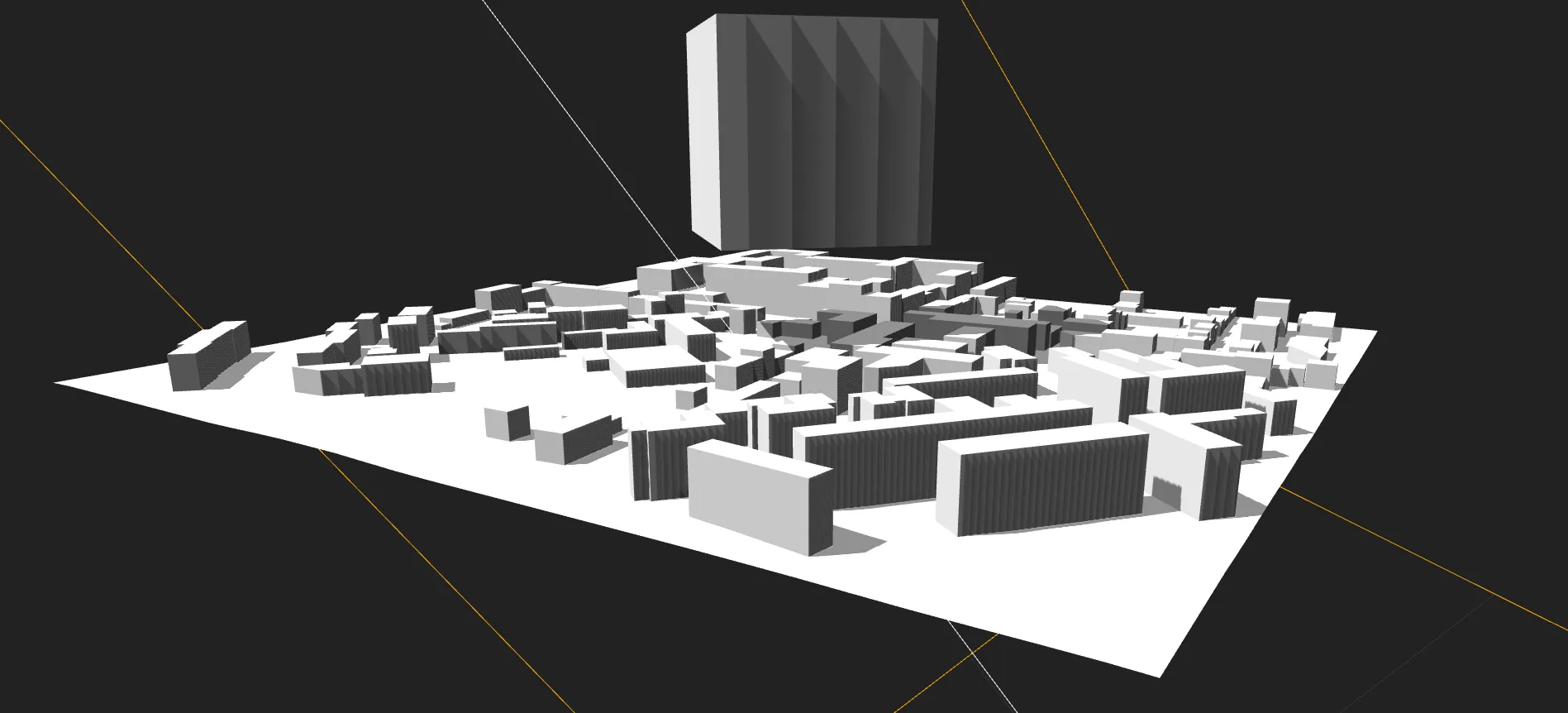我有一个场景,包含两个Collada对象和一个定向光源。第一个Collada对象基本上是一个平面,第二个由多个盒子组成。
似乎当场景被渲染时,“侧边”的阴影被很大程度地削弱了,尽管在地面上的阴影渲染得非常好。
 .
.
当我在寻找答案时,我发现这可能是我的Collada文件的问题,因此我添加了一个基本的立方体到场景中(最上面的大立方体),但是它似乎也有同样的问题。
是否有人有提示或已经知道这个问题?
我正在使用最新的three.js修订版本(r71),在Google Chrome和Mozilla Firefox(MacOS)上测试过。我已经尝试调整了`directional light`的几乎所有`shadow*`属性,除了与`shadowCascade`相关的属性(我没有使用)。我还测试了调整与阴影相关的渲染器属性。
这是我的光源设置:
var directionalLight = new THREE.DirectionalLight( 0xffffff, 1 );
directionalLight.target.position = THREE.Vector3(0, 0, 0);
directionalLight.position.set( 250, 500, 250 );
directionalLight.castShadow = true;
directionalLight.shadowCameraNear = 100;
directionalLight.shadowCameraFar = 1000;
directionalLight.shadowMapWidth = 2048;
directionalLight.shadowMapHeight = 2048;
directionalLight.shadowBias = 0.0001;
directionalLight.shadowDarkness = 0.5;
directionalLight.shadowCameraLeft = -300;
directionalLight.shadowCameraRight = 300;
directionalLight.shadowCameraTop = 300;
directionalLight.shadowCameraBottom = -300;
directionalLight.shadowCameraVisible = true;
我的collada对象有点大,所以我的shadowCamera界限也很大。
我的渲染器设置:
renderer = new THREE.WebGLRenderer( {antialias: true} );
renderer.setClearColor(0x222222);
renderer.shadowMapEnabled = true;
renderer.shadowMapSoft = true;
renderer.shadowMapType = THREE.PCFSoftShadowMap;
renderer.setPixelRatio( window.devicePixelRatio );
renderer.setSize( window.innerWidth, window.innerHeight );
这是另一种场景的视图,主要展示我的灯光设置。编辑:以下是片段:
var container;
var camera, scene, renderer, controls;
var particleLight;
scene = new THREE.Scene();
init();
animate();
function init() {
container = document.createElement( 'div' );
document.body.appendChild( container );
camera = new THREE.PerspectiveCamera( 45, window.innerWidth / window.innerHeight, 1, 2000 );
camera.position.set( 300, 100, 0 );
// Controls
controls = new THREE.OrbitControls( camera );
// Cube
var geometry = new THREE.BoxGeometry( 100, 100, 100 );
var material = new THREE.MeshLambertMaterial();
var cube = new THREE.Mesh( geometry, material );
cube.position.y = 50;
cube.rotation.y = 0.8;
cube.castShadow = true;
cube.receiveShadow = true;
scene.add( cube );
// Plane
var planeGeometry = new THREE.PlaneBufferGeometry( 300, 300, 300 );
var plane = new THREE.Mesh( planeGeometry, material );
plane.position.set( 0, 0, 0 );
plane.rotation.x = -1.6;
plane.castShadow = true;
plane.receiveShadow = true;
scene.add( plane );
// Light
var directionalLight = new THREE.DirectionalLight( 0xffffff, 1 );
directionalLight.target.position = THREE.Vector3(0, 0, 0);
directionalLight.position.set( 250, 500, 250 );
directionalLight.castShadow = true;
directionalLight.shadowCameraNear = 100;
directionalLight.shadowCameraFar = 1000;
directionalLight.shadowMapWidth = 2048;
directionalLight.shadowMapHeight = 2048;
directionalLight.shadowBias = 0.0001;
directionalLight.shadowDarkness = 0.5;
directionalLight.shadowCameraLeft = -300;
directionalLight.shadowCameraRight = 300;
directionalLight.shadowCameraTop = 300;
directionalLight.shadowCameraBottom = -300;
directionalLight.shadowCameraVisible = true;
scene.add( directionalLight );
scene.add( new THREE.AmbientLight( 0x555555 ) );
renderer = new THREE.WebGLRenderer( {antialias: true} );
renderer.setClearColor(0x222222);
renderer.shadowMapEnabled = true;
renderer.shadowMapSoft = true;
renderer.shadowMapType = THREE.PCFSoftShadowMap;
renderer.setPixelRatio( window.devicePixelRatio );
renderer.setSize( window.innerWidth, window.innerHeight );
container.appendChild( renderer.domElement );
window.addEventListener( 'resize', onWindowResize, false );
}
function onWindowResize() {
camera.aspect = window.innerWidth / window.innerHeight;
camera.updateProjectionMatrix();
renderer.setSize( window.innerWidth, window.innerHeight );
}
function animate() {
requestAnimationFrame( animate );
render();
}
var clock = new THREE.Clock();
function render() {
var timer = Date.now() * 0.0005;
camera.lookAt(new THREE.Vector3(0, 0, 0));
renderer.render( scene, camera );
}<script src="https://cdnjs.cloudflare.com/ajax/libs/three.js/r71/three.min.js"></script>
<script src="http://threejs.org/examples/js/controls/OrbitControls.js"></script>
THREE.PlaneBufferGeometry(300, 300, 1, 1)代替。 - WestLangley